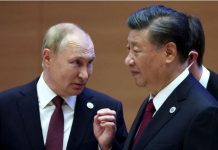Fifteen EU member states have breached rules by forging bilateral commercial deals with China as part of Beijing’s ambitious Belt and Road Initiative, according to a report published by the European Court of Auditors.
Auditors investigated the scope of Chinese investments in the EU and identified „multiple risks” of a political and economic nature.
They also drew attention to how some member states have been systematically violating EU rules in bypassing the European Commission before finalizing trade deals with China, Euractiv reported.
China is now the EU’s second-biggest trading partner behind the United States, while the EU is China’s biggest trading partner.
The EU says it’s committed to boosting trade with China, but wants to ensure that China trades fairly, respects intellectual property rights and meets its obligations as a member of the World Trade Organization.
Italy, Greece, Estonia, and Croatia are among the member states that have bilateral agreements with China, auditors said.
The Belt and Road Initiative is a landmark development plan involving infrastructure and investments crossing more than 80 countries in Europe, Asia and Africa.
Another issue uncovered in the report was the alleged EU funding of Chinese Belt and Road projects on the bloc.
The court found that the Commission allocated 357 million euros in cohesion funds to cover 85% of the cost of the Peljesac bridge in Croatia. The contract was then awarded to a Chinese consortium led by the SOE China Road and Bridge Corporation.
“This bridge was financed by EU cohesion funds, yet it is being branded as being part of China’s Belt and Road initiative,” chief auditor of the report Annemie Turtelboom Turtelboom noted.
After consulting with the European Commission, the European Court of Auditors found that the EU executive has not been consulted prior to any of the agreements being made, a violation of a 1974 Council decision that states EU nations are obliged to inform the Commission of „cooperation agreements” relating to economic or industrial partnerships with third countries.
Turtelboom told reporters that the EU should adopt a more unified approach in its dealing with the world’s second-largest economy.
“What we are seeing in our report is divide and rule within the European Union,” she said. “That’s what we are seeing all the time. We need 27 players on one team.”
Another frustration of auditors, Turtelboom said, was the deficit of publicly available information and data on Chinese investments in the EU.
“There is no publicly available inventory of official .. projects, nor is there an inventory on member states contributions to financial institutions involved in the,” initiative, she said.
“There is no comprehensive risk analysis, and this leads us towards the question if the EU is driving blind towards China. It certainly appears that we are sailing with no compass, as we found no formalised comprehensive analysis of the risks and opportunities for the EU on China’s investment strategy.”
The court wants to see increased transparency about Chinese investments in Europe.
In addition, the supply of Chinese telecommunications equipment to the European market is also referenced in the report, with member states taking diverging positions with regards to their cooperation with China on 5G.
Countries politically aligned with the United States adopted a hostile approach to working with China on 5G, including the Czech Republic, Latvia, Estonia, Poland, and Romania, while other nations, such as Germany and Belgium have been cautious, but not explicitly hostile.
The report also highlighted that “a particular threat stems from cyber offensive initiatives of non-EU countries,” in a veiled reference to Huawei.
The Commission is charting more of a harmonized approach to 5G technology in Europe, in view of current objectives in the field which include the launch of 5G services in all EU member states by the end of 2020 at the latest, as well as a ‘rapid build-up’ that will ensure “uninterrupted 5G coverage in urban areas and along main transport paths by 2025,” as outlined in the 5G Action Plan for Europe.
An EU-China summit is scheduled for Monday.
In 2013 the EU and China started negotiations for an Investment Agreement to provide investors with predictable, long-term access to the EU and Chinese markets and to protect investors and their investments.




















